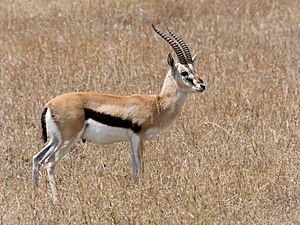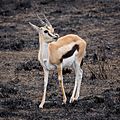Thomson's gazelle facts for kids
Quick facts for kids Thomson's gazelle |
|
|---|---|
 |
|
| Conservation status | |
| Scientific classification | |
| Kingdom: | |
| Phylum: | |
| Class: | |
| Order: | |
| Family: | |
| Subfamily: |
Antilopinae
|
| Genus: | |
| Binomial name | |
| Gazella thomsonii Günther, 1884
|
|
The Thomson's gazelle (Gazella thomsonii) is a small antelope and the most common gazelle found in East Africa. People often call them "tommies." They got their name from an explorer named Joseph Thomson. These gazelles live on ranches and farms across East Africa. They are very tough and can survive in places where other animals have moved away.
Contents
What Does a Thomson's Gazelle Look Like?
Thomson's gazelles, or "tommies," are not very big. They stand about half a meter (22-26 inches) tall. They usually weigh between 15 and 25 kilograms (35-55 pounds). Tommies look a lot like Grant's gazelles. However, they have special features that help you tell them apart.
Where Do Thomson's Gazelles Live?
Tommies have learned to live in the dry, open grasslands of East Africa. You can find them mostly in southern Kenya and northern Tanzania. Even though many predators hunt them, tommies often stay in areas long after other animals have left.
Who Hunts Thomson's Gazelles?
Thomson's gazelles have many animals that hunt them. These include cheetahs, lions, leopards, and hyenas. Cheetahs are their main hunters. Cheetahs can run faster than gazelles for a short time. However, gazelles can run fast for longer. They can also make quick turns, which helps them escape.
A Thomson's gazelle can run incredibly fast. They can reach speeds from 80 km/h (50 mph) up to 96 km/h (60 mph). They also run in a zigzag pattern. This tricky move often saves them from being caught.
Sometimes, leopards, lions, and hyenas also chase them. But gazelles are usually faster and more agile. These bigger predators often try to catch young or sick gazelles. Crocodiles and pythons can also eat them. Young gazelles, called fawns, might be hunted by eagles, jackals, and baboons.
One interesting thing Thomson's gazelles do is a special jump. It's called stotting or pronking. They do this to surprise predators. It also shows how strong and healthy they are.
See also
 In Spanish: Gacela de Thomson para niños
In Spanish: Gacela de Thomson para niños
Images for kids








